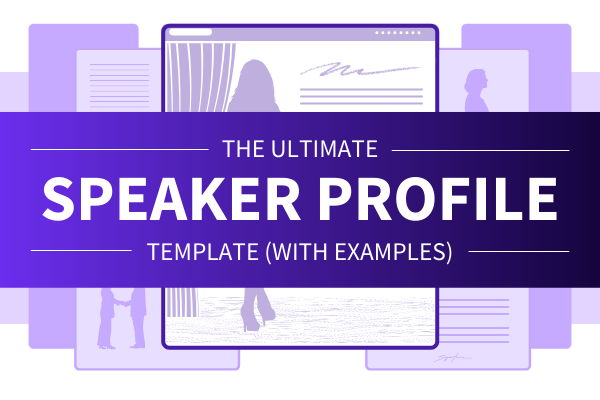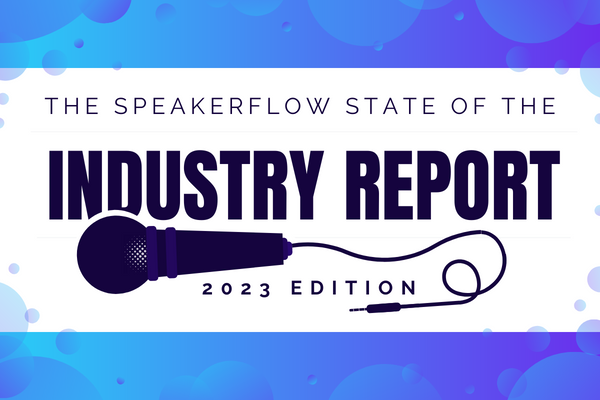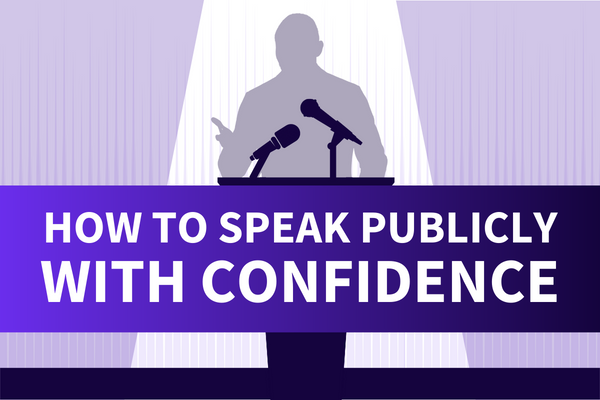A speaker profile template is a way to summarize your education, history, and experience to sell your speaking expertise. This is commonly used when you’re pitching a conference or event. Also known as a speaker one-sheet and speaker bio, the ultimate speaker profile template highlights your topic areas, contact details, and rates in a quick, efficient format.
When it comes to landing impressive speaking events, you need to go beyond talking the talk. You also have to walk the walk. A speaker profile positions you as a thought leader and professional. Better yet, you don’t need any extensive experience or skills to create your own speaker profile.
With that in mind, you don’t have to reinvent the wheel. In fact, it helps to use an established speaker profile template conference leaders are already familiar with. When you use an expected template or framework, it’s efficient for decision-makers to review your highlights reel quickly. While there’s always room for creativity, you only have a few seconds to make a strong impression.
Most professional speakers focus on their website and social media presence, but this is only one side of the story. Successful professional speakers know that every impression counts. You and your business only have 7 seconds to make a first impression. Every second counts. That’s why we created the ultimate speaker profile template with clear examples so you can create your own with confidence.
What is a speaker profile?
First, what even is a speaker profile? As the name implies, this is a quick biography about your achievements, history, and experience. It includes a full profile of why a conference or event should choose you as a speaker. There is no one-size-fits-all when it comes to speaker profiles, but most include some variation of the following:
- Bio: A short and sweet bio explaining who you are and why you stand out. This can range from a few words to several paragraphs, depending on the context.
- Contact information: Like a business card, you want to make sure your contact details are easy to find. This could include a website, email, phone number, and even social media profiles.
- Testimonials: If you have previous testimonials or stories, you might share one that stands out.
- Photos: It’s also common to include a headshot on your speaker profile, as well as photos of your speaking. Seeing you in action helps you show rather than tell, and it communicates confidence.
- Topics: Share possible titles of your talks or events, and describe what you’ll cover in these sessions.
- Experience: If you’ve been featured in other conferences, events, or publications, highlight this prior experience.
- Rates: Lastly, share your offerings and rates. You should include different packages, including what each option covers and a rate range.
All of this information should be as brief as possible. While you might have more to say, limiting your speaker profile to a single page allows the event leader to quickly learn what they need to know. While they want to make the right choice, the people in charge of large events are busy. This is why a speaker profile is so valuable as a marketing tool. Whether your profile appears online or in print, you want it to stand out.
What’s the difference between my speaker profile, speaker biography, and speaker one sheet?
With that in mind, it’s common to get confused between all of the terms you see in the speaker space. While you’re likely to see these used interchangeably, they have very specific definitions. The terms “speaker profile,” “speaker biography,” and “speaker one sheet” mean distinct things. Let’s break down the key differences to get the facts straight.
- Bio: A bio or speaker biography is a written description of your professional experiences that relate to your areas of expertise. This should include awards, noteworthy accomplishments, certifications, and so on. In other words, your bio is anything you would put in a highlight reel. For instance, you might include being featured on “Forbes’ 30 Under 30 List” as part of your bio.
- Profile: A profile is when a professional description of you and your work appears online or in print. This includes a bio, photos of you speaking, headshots, awards, pricing information, or details about your speaking programs. While all of these elements aren’t necessary, a profile shows a comprehensive glimpse into your expertise.
- One sheet: Lastly, a speaker one sheet is a professionally designed summary of your speaker profile. This is commonly included on your website or linked to social media pages. As the name implies, a “one sheet” is usually a single page. Creating a killer one sheet is an important marketing tool for speakers.
While you might see these terms used interchangeably, note how they refer to very specific things in the speaking space. They all have their own roles, and it’s common for professional speakers to develop all of the above. If you’re trying to get paid to speak, you have to become a master of first impressions both online and offline.
What does a speaker profile template look like?
Next, what does a speaker profile template look like on different mediums? Whether you’ve been speaking professionally for years or you’re just getting started, the general speaker profile template is the same across the board. At a minimum, you should have these things on your speaker profile. The goal is to give a clear picture of why you’re the right fit for your audience.
Social Media
To begin, since we’re living in the digital age, you need to have some kind of online presence. If you’re keeping things simple, you’ll want to have a short bio and a link to your website URL at the very least. Otherwise, if you have the space, include more detailed information such as key topic areas, awards, and achievements.
However, keep in mind that most people following you on social media won’t be looking to hire you. If they were, they’ll likely take those extra steps to dig deeper into your contact info. This means it’s not usually appropriate to list your rates, phone number, or any other in-depth details on your social profiles.
Media Appearances
Next, if you’re lucky to land media appearances, congrats! This is a wonderful form of social proof, but it does have more limitations than other speaker profile templates on this list. When your speaker profile is featured on someone else’s platform, you have to default to their expectations. It’s up to the discretion of the host what you can or cannot include as part of your speaker profile.
For podcasts, you typically can include a short bio, headshot, and links to social profiles and websites. If you’re not sure, always ask what information your host is willing to feature on your behalf. On the SpeakerFlow podcast, for example, we share guest resources that benefit our listeners. The key is usually in providing context, trust, and value.
Event Appearances
Again, when your speaker profile is highlighted as part of an event, you default to what the host wants. In most cases, you’ll share a bio, headshot, and your website URL. This is when it pays to get creative with your bio. Make sure you specifically tailor your professional bio to the particular event, drawing attention to your most relevant topic areas.
You can also be mindful of the website URL you include. Linking to a specific page on your website with targeted information, like a landing page, is a great idea. You might also share specific resources relevant to the event or your speaking topic. A bit of creativity goes a long way with event appearances.
Speakers Bureau Websites
On the other hand, you have an opportunity to go more in-depth on speaker bureau websites with your speaker profile. You can share a description of your programs, pricing, areas of expertise, ideal audience, awards, certifications, speaking photos, bio, and more.
That being said, keep in mind you only have a few seconds to make an impression. Event organizers want to find key information quickly. Using simplified bullet points makes it possible for event leaders to spot the most important details quickly. Nobody wants to sift through a wall of text—and they won’t. Reviewing some examples on eSpeakers is a great way to get inspired.
Your Website
Last but not least, your website is an opportunity to fully create your own speaker profile. This should be your most detailed profile of all, and you can space out your details on multiple pages. While you might adjust your bio to appear in several places on your website, it’s common to create an event planners page specifically for those hiring for events.
This event planner page should resemble a speakers bureau listing in that it shares relevant information, a downloadable one-sheet, and pricing. Your website is a chance to let your brand voice shine. More importantly, you have the space and control to really customize the experience to your audience.
How can I use this speaker profile template in my speaking business?
Now that you know what different speaker profile templates look like, how can you use these as a marketing tool for your speaking business? This profile is more than just something that exists in print or cyberspace. It’s an ever-changing way to promote yourself to find new opportunities.
Your Online Speaker Profile
To begin, your online speaker profile is about more than self-promotion. While promotion is important, your online presence also has its own SEO potential. You can target specific search engine keywords to appear in results, increasing your chances of getting noticed. For example, if you specialize in virtual keynote speaking, you can include the key phrase “virtual keynote speaker” throughout your online speaker profiles.
Beyond SEO-optimization, your online speaker profile is also a way to widen your audience. Using media appearances and social profiles as the dynamic tools they act as social proof in their own right. With 40% of users finding new brands and personalities to follow based on personal recommendations, you can’t understate the value of social proof.
Your Print Speaker Profile
Similarly, your print speaker profile also carries its own weight. While you have less control over this, a well-executed print profile leads to endless opportunities. Because print profiles carry physical weight in person, they often are more trustworthy. Better yet, they can turn a one-time gig into future opportunities.
For example, say you’re a speaker at an in-person networking event. Your audience might take note of your bio and website on the program, looking you up for future events. Any time you share your bio and website, whether in person or online, treat this as an opportunity to market yourself (because it is).
Leverage This Winning Speaker Profile Template
Ultimately, a speaker profile template helps you identify key areas to promote yourself. This is far from one-size-fits-all, but there are industry standards to consider. It’s important to know when to share a detailed bio, how to link to your top resources, and whether it’s appropriate to talk about price. Though some of this comes with experience, you need a speaker profile at any level.
If you want to be an expert thought leader, you need to act like one. This means positioning yourself in the context of someone who regularly speaks professionally. Now is the time to create the perfect speaker profile template for your audience, considering how you stand out from the rest. A bit of pre-planning goes a long way. Are you always ready to make a strong first impression?





